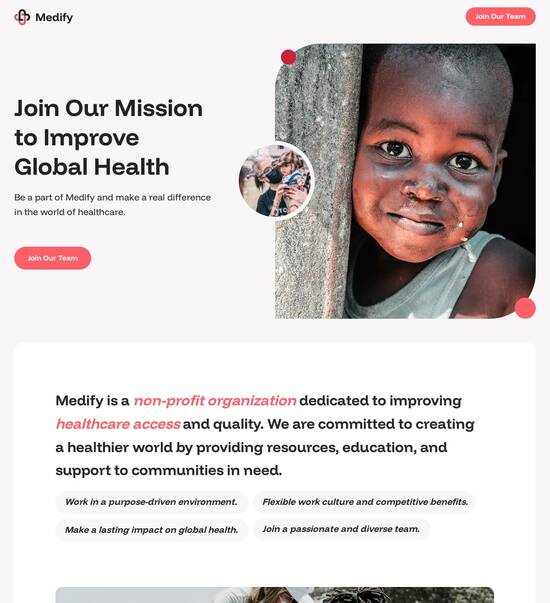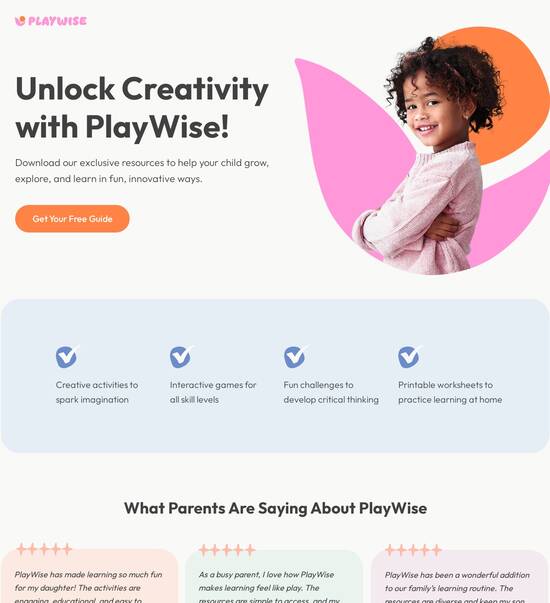
HTML page template for Reporting analysts
Use TemplateAbout template
Attract clients and showcase your skills with style using our landing page templates for Reporting analysts. Let's convert those visitors into clients!
Recommended templates

Easy to build without coding
With the intuitive drag-and-drop builder, anyone on your team can create high-converting pages without any knowledge of code or design. Make enhancements to your landing page with custom widgets using Javascript, HTML/CSS, or third-party scripts.

Multiple layouts for any industry and goal
Select from 500+ landing page layouts built to boost conversions across industry-specific scenarios. Customize them by adjusting fonts, adding images, and generating on-brand content with the AI assistant. Quickly scale with Instablocks® and Global Blocks that you can save, reuse, and update globally.

Loads fast and looks polished on any device
Every template is responsive, which means they present professionally on any device and load blazingly fast with our Thor Render Engine. You can also power them up with Google AMP technology to deliver an unparalleled mobile experience and drive higher conversions.

Robust analytics & experimentation
Get real-time updates and reporting across all your devices, showing the number of visitors, conversions, cost-per-visitor, and cost-per-lead. Launch AI-powered experiments, run A/B tests, and use heatmaps to analyze user behavior, then optimize your landing page to maximize conversions.







Easy to build without coding
With the intuitive drag-and-drop builder, anyone on your team can create high-converting pages without any knowledge of code or design. Make enhancements to your landing page with custom widgets using Javascript, HTML/CSS, or third-party scripts.
Multiple layouts for any industry and goal
Select from 500+ landing page layouts built to boost conversions across industry-specific scenarios. Customize them by adjusting fonts, adding images, and generating on-brand content with the AI assistant. Quickly scale with Instablocks® and Global Blocks that you can save, reuse, and update globally.
Loads fast and looks polished on any device
Every template is responsive, which means they present professionally on any device and load blazingly fast with our Thor Render Engine.
Robust analytics & experimentation
Get real-time updates and reporting across all your devices, showing the number of visitors, conversions, cost-per-visitor, and cost-per-lead. Launch AI-powered experiments, run A/B tests, and use heatmaps to analyze user behavior, then optimize your landing page to maximize conversions.
All the features you need to build website analysis report template
Explore more featuresLearn how to build report template html
Frequently asked questions about website reporting template
Leading the way in building high-performing landing pages





Html reporting template: Your ultimate how-to guide
In the competitive landscape of digital marketing, having an effective landing page template is crucial for capturing leads and optimizing conversion rates. Instapage offers powerful tools that enable marketing professionals across various sectors to create high-impact landing pages that resonate with their target audiences. This guide will walk you through the essential steps to harness the full potential of Instapage's features while maximizing your ROI.
Understanding landing page templates
Landing page templates are pre-designed webpage frameworks that marketers can customize to serve specific campaigns. Instapage provides over 100 conversion-focused layouts that eliminate the need for time-consuming design processes. By utilizing these templates, you can boost your campaigns more effectively, ensuring that every element aligns with your overall marketing strategy.
- Ease of Use: Templates allow for quick modifications, drastically reducing the time it takes to set up a new campaign.
- Customization: Marketers can adjust content and layout to match branding and campaign goals.
- Proven Designs: The templates offered by Instapage are based on high-converting designs, which means you can leverage tested layouts to boost conversions.
Creating high-converting landing pages
Now that you understand landing page templates, it's essential to know how to utilize them effectively. Begin by selecting a template that aligns with your marketing goals.
- Choose the Right Template: Assess which design best reflects your brand's messaging and offers a clear call to action.
- Add Compelling Content: Focus on headlines and visuals that resonate with your target audience, using dynamic text replacement for personalization.
- Incorporate Lead Generation Elements: Use built-in lead generation forms to capture user information seamlessly.
Optimizing your landing pages
Once your landing page is live, the optimization process can begin. Instapage provides advanced features that help analyze and enhance performance.
- Conduct A/B Testing: Regularly test variations of headlines, images, and CTAs to find out what resonates best with your audience.
- Use Heatmaps: Monitor user interactions on your pages to identify areas for improvement.
- Analytics Dashboard: Leverage Instapage's analytics tools to gauge the performance of each landing page.
By continuously optimizing your landing pages, you can significantly increase conversion rates and lead generation.
Overall, using Instapage's landing page template puts you in a position to succeed by leveraging a powerful framework that drives results.
Get started today on your path to better marketing performance by accessing Instapage's extensive library of templates and tools designed for your needs.
People also ask about analytics template html
HTML page template for reporting analysts
The significance of HTML templates in data reporting
Reporting analysts play a critical role in transforming raw data into actionable insights. They are responsible for collecting, analyzing, and presenting data in a way that helps organizations make informed decisions. One of the key aspects of this role is the need to visualize complex data sets effectively. Good data visualization not only simplifies understanding but also enhances engagement among stakeholders.
The importance of data presentation cannot be overstated; a well-structured report can influence decision-making processes dramatically. However, reporting analysts often face challenges such as tight deadlines, the need for accuracy, and the requirement to communicate findings clearly. These difficulties underscore the need for efficient reporting tools and templates.
HTML templates stand out as an effective solution to streamline the reporting process. By leveraging the capabilities of HTML, analysts can produce reports that are not only visually appealing but also interactive and easy to share with various audiences. This improvement in format can significantly assist in overcoming common hurdles, thus enhancing productivity.
HTML templates: A game changer for analysts
HTML templates are predefined page layouts that serve as a foundation for creating various types of reports. Their primary purpose is to facilitate the efficient presentation of data, making it easier for analysts to focus on content rather than design. Using HTML as a reporting format offers numerous advantages over traditional formats like PDFs or Word documents.
One of the main advantages of using HTML is its improved accessibility. HTML pages can be viewed on any device with a web browser, making it convenient to share insights with team members who may be accessing information on tablets, laptops, or smartphones. Additionally, HTML supports interactive features, allowing users to engage with data dynamically through filters, charts, and graphs.
Key features of HTML page templates for reporting analysts
To maximize the effectiveness of HTML templates for reporting, certain features are essential. First, responsive design is crucial in ensuring that reports adapt seamlessly across different devices. A responsive template provides a user-friendly experience regardless of screen size, allowing stakeholders to access information anywhere. For example, an analysis performed on a mobile phone should convey the same clarity as it would on a desktop screen.
Responsive design enables adaptability across devices, ensuring clarity on mobile and desktop views.
Interactive widgets like charts and graphs enhance user engagement and understanding of data trends.
Dynamic data integration allows reports to reflect real-time changes, offering accurate insights.
Including interactive widgets, such as charts, graphs, and tables, also significantly enhances reports. These elements help illustrate data visually, providing readers with quick insights into the trends and discrepancies that might not be evident from raw numbers alone. Furthermore, the capacity for dynamic data integration is essential for maintaining up-to-date reports. Analysts can embed real-time data feeds that synchronize with the report, making it a reliable resource for ongoing analyses.
Customizable layout options are another vital feature of HTML templates. Analysts can design templates with pre-defined sections suitable for various types of reporting. For instance, a template can include designated areas for executive summaries, in-depth analysis, and visualization sections, allowing for organized content presentation. Personalizing these elements can further enhance individual analyses and brand representation.
Building your HTML page template: Step-by-step
To create an effective HTML page template for reporting, start with a clear understanding of its purpose and target audience. Identifying specific reporting goals helps shape the structure and content of the template. A reporting analyst must consider the expectations of stakeholders, ensuring that the report's design aligns with their needs and comprehension levels.
Once the purpose is established, the next step is designing the layout. Choosing the right framework is essential in this phase. Popular frameworks like Bootstrap and Foundation offer various pre-designed components and grid systems that simplify the development of responsive templates. Analysts should select a framework that aligns with their project requirements and skill set.
Choosing an appropriate framework, such as Bootstrap, simplifies design and responsiveness.
Structuring content effectively requires attention to best practices for clarity and flow.
Incorporating functional widgets enriches reports and enhances user interaction.
Optimization techniques for maximizing impact
To ensure that HTML page templates are effective in achieving their reporting goals, optimization techniques should be implemented. One critical aspect of optimization is adhering to SEO best practices. Although reporting is often centered around internal stakeholders, having a web-accessible report can enhance visibility if made public. This requires implementing elements like meta tags and descriptive titles that aid in search engine indexing.
Further, the use of image alt text is essential for accessibility. Providing descriptive text for images allows screen readers to convey information to visually impaired users. By incorporating these practices, reporting analysts can not only improve their reports' visibility but also enhance usability and audience engagement.
In addition to SEO, incorporating analytics tracking within the templates is essential for measuring engagement levels. By utilizing tools like Google Analytics, analysts can gain insights into how users interact with reports. This data informs future adjustments to content, ensuring that reports remain relevant and useful. For example, knowing which sections receive the most attention can guide analysts in highlighting important insights.
Leveraging the HTML template with content management systems (CMS)
Integrating HTML templates with popular Content Management Systems (CMS), such as WordPress and Joomla, further enhances their functionality. The process of importing templates into a CMS typically involves uploading HTML files and configuring settings to match the site's structure. This integration allows reporting analysts to leverage the powerful tools that CMS platforms offer while maintaining the benefits of HTML templates.
The advantages of using HTML templates within a CMS extend to streamlined workflows for updating and publishing reports. By centralizing management, analysts can efficiently handle multiple reporting projects from one interface, reducing effort and improving consistency across reports. This capability becomes particularly valuable in environments that require swift updates and adaptability.
Real-world applications: Success stories and use cases
Numerous organizations across various industries have successfully implemented HTML page templates to enhance their reporting processes. For instance, a financial services firm utilized HTML templates to streamline monthly performance reports, allowing stakeholders easier access to visualized data that aids in decision-making. The efficiency gained through this approach saved hours of conventional report preparation.
Moreover, user testimonials confirm that adopting HTML templates led to improved clarity and engagement during presentations. Analysts noted that stakeholders were much more involved with interactive reports compared to traditional formats. However, while implementing these templates, analysts must also be aware of common pitfalls to avoid.
Avoid overcomplicating design—keeping templates clean and straightforward enhances clarity.
Neglecting usability can backfire; ensure content organization remains intuitive.
Failing to test responsiveness can lead to accessibility issues across devices.
Future trends in reporting with HTML templates
The rapid evolution of technology presents exciting opportunities for the future of reporting with HTML templates. Emerging technologies, particularly artificial intelligence, are beginning to find their way into data reporting. For instance, AI-powered analytics can automatically generate insights and recommendations from the data, significantly shortening the time required to prepare reports.
Moreover, we can expect increasingly innovative HTML templates that incorporate advanced features such as machine learning for predictive analytics. This advancement will allow analysts to offer foresight rather than just insights, enhancing the overall value of their reports. This progression hints at a future where reports not only inform but also guide strategic direction.
As the demand for data-driven decisions rises, the interactivity and engagement that HTML page templates can provide will likely become a standard expectation among audiences. Analysts may also find themselves developing collaborative tools within reports to facilitate discussion among stakeholders.
Conclusion: The path forward for reporting analysts
In summary, HTML page templates represent a significant evolution in how reporting analysts approach data presentation. The benefits of HTML templates—including enhanced interactivity, accessibility, and customizable features—transform the way reports are created and consumed. By adopting these innovative templates, analysts can address common challenges while maintaining a strong focus on delivering insights that advance their organizations' objectives.
For reporting analysts, this is a call to action to embrace HTML templates fully. By integrating these tools into their workflows, they can produce reports that are not only visually appealing but also practical and engaging, thus significantly impacting decision-making processes.
Ready to skyrocket conversions?
Supercharge your ad campaigns with high-performing landing pages
Get started














